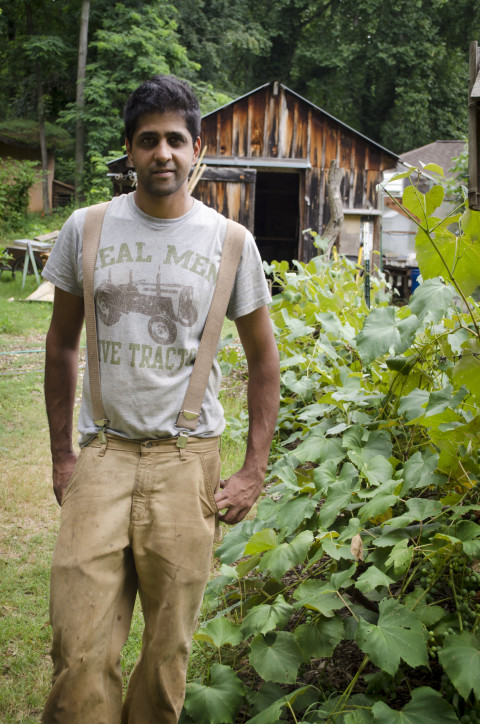Historically, food systems in the Appalachian Mountains relied on tight-knit communities working together to create food security on a local level. These traditional agricultural systems made food and food production an intimate and inextricable part of daily life. But today those everyday interactions — with the plants, animals and the practice of raising them — are becoming less and less common.
In 1790, 90 percent of Americans were farmers. Today that figure is less than 1 percent. The change is particularly noticeable in the South, which up until the 1950s, was a largely agrarian society. Now, some are calling for a rebuilding and supporting of a locally focused food system, which used to be prevalent in Appalachia.
“Traditional agriculture in Appalachia was highly local,” says James Veteto, executive director of the Appalachian Institute for Mountain Studies in Celo, who teaches at Western Carolina University. “It was supplemented by hunting, fishing and wildcrafting of a wide variety of locally available, seasonal wild foods and medicines … and there was a fair amount of trade.”
Veteto and others at AIMS are working to foster food systems that blend Appalachian environmental knowledge with modern technology. They hold classes on traditional agriculture, permaculture, wild food and medicinal herbs, supporting a resurgence of the principles of older “folk systems” into a modern economy.
“Folk systems typically rely on and utilize a much broader array of biodiversity than modern agriculture,” says Veteto, who notes that modern “folk agriculture” — often a hybrid of folk systems and modern adaptations — is generally more sustainable than mainstream industrial agriculture.
That focus on sustainability is driving the return to these traditional systems for many local growers who also want to see the concept brought into urban areas.
“Where we live, work and play is where we should be producing all the foods and things best eaten fresh or right away,” says Sunil Patel of Patchwork Urban Farms. “Putting this back into our urban areas, where it belongs, is what I’m trying to envision happening.”
At Patchwork, Patel employs traditional farming methods, including crop rotation, planting cover crops to enrich the soil naturally, composting and animal integration. Patel also uses waste from restaurants and households to produce compost, as well as animal protein sources such as the larva of the black soldier fly. He adds biochar to the soil, a method he notes goes “way back to pre-colonial South America.”
“I don’t use any synthetic pesticides, herbicides or fertilizers,” Patel says. “I use biodynamic methods and pay attention to the energetic effects of the Earth, moon, planets and stars on the growth of plants and animals.” He adds that even his irrigation methods, including earth-shaping and rainwater catchments, take advantage of natural systems.
Patel says he believes these methods bring the farmer in closer connection to the food system. And when the yield is shared or sold at tailgate markets or local restaurants, the concept spreads out from the farmer and into the community, he notes.
“I feel our connection to our foods system has been lost, and that’s why we need to bring it back,” Patel says. “If we see it enough as a culture, we’ll be able to reconnect with it in a big way.”
Growers seeking to incorporate folk agriculture back into the local economy have been aided by the re-emergence of farmers markets and roadside farm stands. Ordinances passed by Asheville City Council over the last decade have allowed farmers markets to operate in residential areas and removed the permitting requirements for accessory structures — such as greenhouses and hoop houses — and residential farm stands.
“It reflects a focus on returning food security to the neighborhood level,” says City Councilman Gordon Smith in an email to Xpress. “Food access used to happen in lots of places in our lives, not just at grocery stores and restaurants. These changes will mean more food being grown where people live and distributed to people who live there.”
Veteto says the principles of folk systems can also be used noncommerically when neighbors trade their harvests or share the yield of communal gardens.
“There are lots of stories of people, churches, etc., in historical Appalachian communities that cooked meals for people who were suffering from food insecurity,” Veteto says. “I think the role of community used to be much more prominent in proving for community food security and health.”
In fact, Veteto adds, feeding families and communities is the focus of folk agriculture.
“Producing your own sustenance gives you a sense of self-worth, independence and connection to the natural world,” he says. “It is a fundamental, elemental type of empowerment.”
For more information on Appalachian Institute for Mountain Studies, visit facebook.com/AppalachianInstituteMountainStudies. You can find Patchwork Urban Farms at Wednesday Tailgate Market at the French Broad Food Co-op and at a roadside stand open Tuesdays 3-7 p.m. at 124 Choctaw St. For more information, visit patchworkurbanfarms.com.






I would like to follow your posts. Please and thank you?
How do I sign up
How do I sign up. It looks as if I could learn a lot.
Hi Melody, Thanks so much for your interest in this story! Please find me on Facebook: Aiyanna Sezak-Blatt (as I post all my pieces there). Much appreciation for your support & best wishes!